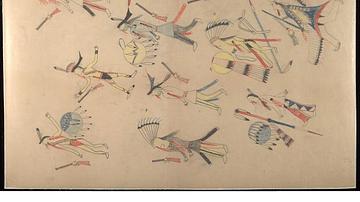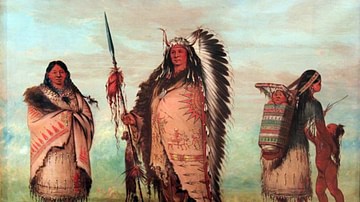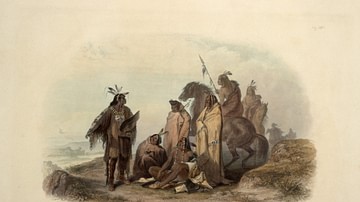The Resuscitation of the Only Daughter is a Sioux story about a young maiden who dies and returns to life, helped by a hunter and his wife, and then lives into old age. The story is open to many interpretations including the concept of fate and that there is a time appointed for one's death.
The story could be interpreted in accordance with one of the seven sacred rites of the Sioux – the Keeping of the Soul – in which a lock of hair from the deceased is taken, purified, and kept in one's sacred bundle (also known as one's medicine bag) for a certain time, usually a year, before it is released to the air, freeing the soul to return to the Great Mystery (Wakan Tanka) at its appointed time. The tale might also be interpreted as encouraging one to make the most of the time one has been given, to mourn one's loss for a culturally appropriate season and then let go and move on, and also to emphasize the importance of hospitality and kindness to strangers – even if they come from the land of the dead.
The tale – which is given as an account of a historical event – includes several details relating to the funerary rituals of the Sioux and their understanding of life after death. The corpse of the young maiden is raised on a scaffold outside of the village and her parents cut their hair short after her death and go into mourning. The hunter and his wife make their camp a half mile away from the burial ground to avoid any "things of the shadow" – the realm of the dead – and yet, when the resurrected young maiden approaches, they welcome her without fear and offer her all hospitality as though she were a living stranger, completely in keeping with the Sioux practice of hospitality in the past as well as today.
At the same time, the Sioux held – and hold – that the dead belong in their own realm and should not return to the world of the living. The story, therefore, inverts a central cultural belief in that the resurrected woman, after being welcomed and healed by the hunter and his wife, goes on to lead a full life, marries three times, and becomes a distinguished physician. Even so, as her life after her resurrection seems to lead to the deaths of her three husbands, the story may still be understood as maintaining the understanding that interaction with the dead is a risky business that brings trouble to those who engage in it, even if it might result in good for others.
Sioux Funerary Rites & Keeping of the Soul
The Sioux, like all Native American nations, believe in the eternal nature of the soul. After the physical death of the body, that which had animated it survives and needs to be acknowledged. The funerary rituals only lay to rest the physical remains of the person, not necessarily their spirit. Scholar Larry J. Zimmerman comments on the Sioux funerary rituals:
A corpse might be cremated, buried, or left to decompose in the open air on a scaffold or in trees. The resulting bones might be left on the ground or later gathered for interment in a conical or linear burial mound. Both scaffolds and burial mounds were sacred areas deemed by some to be spiritually dangerous. Among the Lakota [Sioux], wanagi ("things of the shadow") spirits are said to guard the graves and can harm anyone who disturbs the dead. (247)
The soul itself, however, might also "stand guard" over the corpse, especially, if it had been released from the body before its appointed time. Whether in cases such as these (when a person died young or without an apparent cause) or any other, the Sioux developed the concept of the ritual of the Keeping of the Soul, which has several stages. After a person dies, a lock of their hair is taken and purified over the smoke of sweet grass or sage and is then placed in a sacred bundle. The person who agrees to keep that hair – and so care for the soul of the deceased – takes a vow to live harmoniously for a given time – not engaging in angry altercations or in other types of behavior that might dishonor the spirit they are entrusted with – for at least a year.
At the end of that time (however long it may be), in a ritual ceremony, the soul is released to the heavens and is understood to travel along the Milky Way to attain union with the Great Mystery, the creative force of the universe. The soul is thereby thought to have been released at the appropriate time for such a union in that the Great Mystery (or Great Spirit) will be expecting it. Although there is no mention of this ritual in the story, it may be assumed that the parents of the maiden would have engaged in it and, perhaps, this is how she is able to return to life, because her spirit had not been released to travel on to eternity.

Ghosts who remained on earth to haunt the living, for whatever reason, were not usually welcome – as in many cultures worldwide throughout history – unless they were recognized as friends or family members who had come to deliver some important message. One of the many fascinating aspects of this story is that the maiden, dead two years, returns as an animated corpse and requires the kindness and ministrations of the hunter and his wife to return fully to life. If the hunter were simply cursed afterwards for helping to revitalize the living corpse, this would be in keeping with the cultural understanding of how it was always unwise to interact with the spirits of the dead.
In this story, however, the actions of the hunter and his wife not only revive the maiden but also relieve her parents of their grief and, presumably, restore them to the community and, further, provide the people with an exceptional healer who goes on to help her people into her old age. Although the hunter, and then the maiden's two other husbands, seem to pay for this with their lives, the overall message of the story is positive, which, generally speaking, is at odds with the Native American understanding of interactions with the spirits of the dead.
As in many Native American tales, however, the obvious interpretation is not always the correct one. This story, like many others of the Sioux and other Native American nations, offers many different possibilities of meaning, and ultimately, it is up to an audience to arrive at their own conclusion as to what the final message of the piece might be.
Text
The following is taken from Myths and Legends of the Sioux (1916) by Marie L. McLaughlin, who was part-Sioux. The story continues to be told by the Sioux in various forms in the present day and is a part of their rich cultural heritage.
There once lived an old couple who had an only daughter. She was a beautiful girl and was very much courted by the young men of the tribe, but she said that she preferred single life, and to all their heart-touching talks of deep affection for her, she always had one answer. That was "No."
One day, this maiden fell ill and day after day grew worse. All the best medicine men were called in, but their medicines were of no avail and, in two weeks from the day that she was taken ill, she lay a corpse. Of course, there was great mourning in the camp. They took her body several miles from camp and rolled it in fine robes and blankets, then they laid her on a scaffold which they had erected (as was the custom of burial among the Indians). They placed four forked posts into the ground and then lashed strong poles lengthwise and across the ends and made a bed of willows and stout ash brush. This scaffold was from five to seven feet from the ground. After the funeral, the parents gave away all of their horses, fine robes and blankets, and all of the belongings of the dead girl. Then they cut their hair off close to their heads and attired themselves in the poorest apparel they could secure.
When a year had passed, the friends and relatives of the old couple tried in vain to have them set aside their mourning. "You have mourned long enough," they would say. "Put aside your mourning and try and enjoy a few more pleasures of this life while you live. You are both growing old and can't live very many more years, so make the best of your time." The old couple would listen to their advice and then shake their heads and answer: "We have nothing to live for. Nothing we could join in would be any amusement to us, since we have lost the light of our lives."
So, the old couple continued their mourning for their lost idol. Two years had passed since the death of the beautiful girl, when one evening a hunter and his wife passed by the scaffold which held the dead girl. They were on their return trip and were heavily loaded down with game, and therefore could not travel very fast. About half a mile from the scaffold a clear spring burst forth from the side of a bank, and from this trickled a small stream of water, moistening the roots of the vegetation bordering its banks, and causing a growth of sweet green grass. At this spring the hunter camped and, tethering his horses, at once set about helping his wife to erect the small teepee which they carried for convenience in traveling.
When it became quite dark, the hunter's dogs set up a great barking and growling. "Look out and see what the dogs are barking at," said the hunter to his wife. She looked out through the door and then drew back, saying: "There is the figure of a woman advancing from the direction of the girl's scaffold." "I expect it is the dead girl; let her come, and don't act as if you were afraid," said the hunter. Soon, they heard footsteps advancing and the steps ceased at the door. Looking down at the lower part of the door, the hunter noticed a pair of small moccasins, and knowing that it was the visitor, said: "Whoever you are, come in and have something to eat."
At this invitation, the figure came slowly in and sat down by the door with head covered and with a fine robe drawn tightly over her face. The woman dished up a fine supper and, placing it before the visitor, said: "Eat, my friend, you must be hungry." The figure never moved, nor would it uncover to eat. "Let us turn our back towards the door and our visitor may eat the food," said the hunter. So his wife turned her back towards the visitor and made herself very busy cleaning the small pieces of meat that were hanging to the back sinews of the deer which had been killed (this the Indians use as thread). The hunter, filling his pipe, turned away and smoked in silence.
Finally, the dish was pushed back to the woman, who took it and, after washing it, put it away. The figure still sat at the door, not a sound coming from it, neither was it breathing. The hunter at last said: "Are you the girl that was placed upon that scaffold two years ago?" It bowed its head two or three times in assent. "Are you going to sleep here tonight; if you are, my wife will make down a bed for you." The figure shook its head. "Are you going to come again tomorrow night to us?" It nodded assent.
For three nights in succession the figure visited the hunter's camp. The third night, the hunter noticed that the figure was breathing. He saw one of the hands protruding from the robe. The skin was perfectly black and was stuck fast to the bones of the hand. On seeing this, the hunter arose and, going over to his medicine sack which hung on a pole, took down the sack and, opening it, took out some roots and, mixing them with skunk oil and vermillion, said to the figure:
"If you will let us rub your face and hands with this medicine, it will put new life into the skin and you will assume your complexion again and it will put flesh on you." The figure assented and the hunter rubbed the medicine on her hands and face. Then she arose and walked back to the scaffold. The next day, the hunter moved camp towards the home village. That night, he camped within a few miles of the village. When night came, the dogs, as usual, set up a great barking and, looking out, the wife saw the girl approaching.
When the girl had entered and sat down, the hunter noticed that the girl did not keep her robe so closely together over her face. When the wife gave her something to eat, the girl reached out and took the dish, thus exposing her hands, which they at once noticed were again natural. After she had finished her meal, the hunter said: "Did my medicine help you?" She nodded assent. "Do you want my medicine rubbed all over your body?" Again, she nodded. "I will mix enough to rub your entire body and I will go outside and let my wife rub it on for you."
He mixed a good supply and, going out, left his wife to rub the girl. When his wife had completed the task, she called to her husband to come in and, when he came in he sat down and said to the girl: "Tomorrow we will reach the village. Do you want to go with us?" She shook her head. "Will you come again to our camp tomorrow night after we have camped in the village?" She nodded her head in assent. "Then, do you want to see your parents?" She nodded again, and arose, and disappeared into the darkness.
Early the next morning, the hunter broke camp and traveled far into the afternoon, when he arrived at the village. He instructed his wife to go at once and inform the old couple of what had happened. The wife did so and, at sunset, the old couple came to the hunter's teepee. They were invited to enter and a fine supper was served them. Soon after they had finished their supper, the dogs of the camp set up a great barking. "Now she is coming, so be brave and you will soon see your lost daughter," said the hunter. Hardly had he finished speaking when she entered the tent as natural as ever she was in life. Her parents clung to her and smothered her with kisses.
They wanted her to return home with them, but she would stay with the hunter who had brought her back to life, and she married him, becoming his second wife. A short time after taking the girl for his wife, the hunter joined a war party and never returned, as he was killed on the battlefield.
A year after her husband's death, she married again. This husband was also killed by a band of enemies whom the warriors were pursuing for stealing some of their horses. The third husband also met a similar fate to the first. He was also killed on the field of battle. She was still a handsome woman at the time of the third husband's death, but never again married, as the men feared her, saying she was holy, and that anyone who married her would be sure to be killed by the enemy.
So she took to doctoring the sick and gained the reputation of being the most skilled doctor in the nation. She lived to a ripe old age and, when she felt death approaching, she had them take her to where she had rested once before and, crawling to the top of the newly erected scaffold, wrapped her blankets and robes about her, covered her face carefully, and fell into that sleep from which there is no more awakening.






